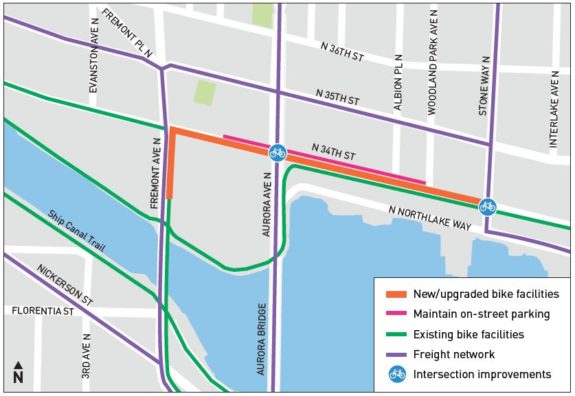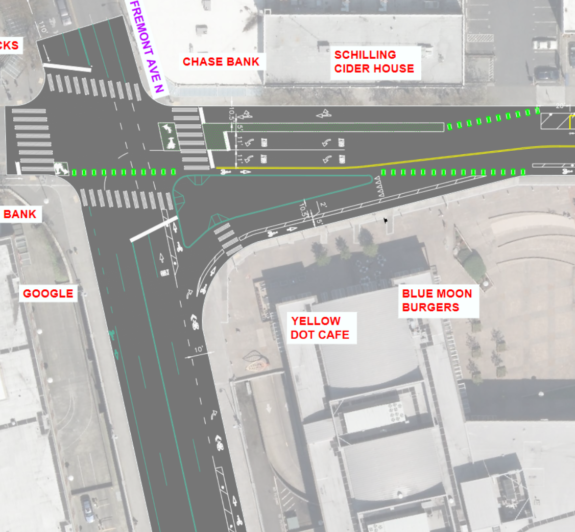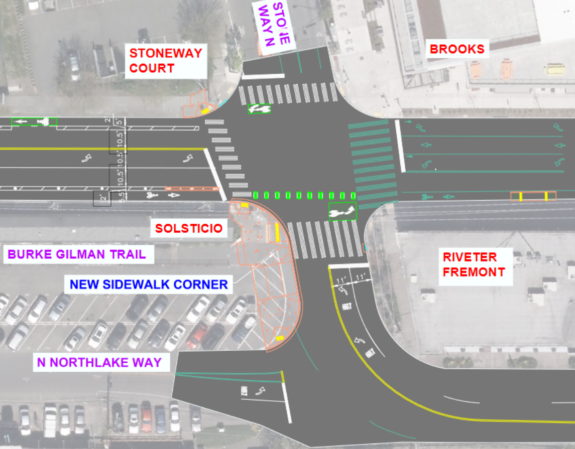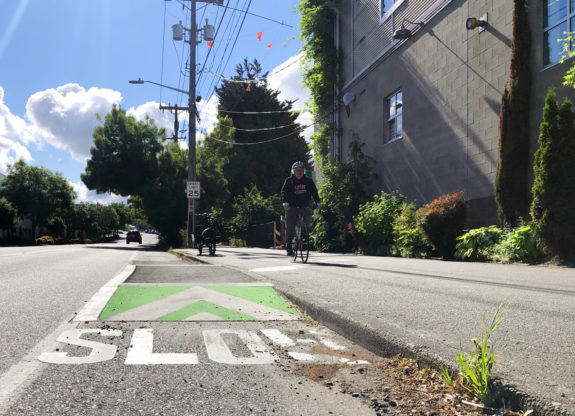
 The latest upgrade to the bike connections around the Fremont Bridge make some very significant improvements, though larger solutions are still needed to make it truly comfortable for people of all ages and abilities.
The latest upgrade to the bike connections around the Fremont Bridge make some very significant improvements, though larger solutions are still needed to make it truly comfortable for people of all ages and abilities.
The Burke-Gilman Trail is the region’s busiest bike trail, and it travels under the Fremont Bridge, which is the region’s busiest bridge for biking. So connecting the two is a very obvious, high-demand need of regional importance.
The biggest changes are new protected bike lanes for most of N 34th Street between Fremont Ave and Stone Way, an extended bike lane for people biking north across the bridge, and a much larger sidewalk extension for trail users at Stone Way. These are all significant improvements.
N 34th Street already had painted bike lanes, but they were fairly skinny. Worst of all, the westbound lane was located in the door zone of parked cars and was often blocked by people making deliveries or dropping off passengers. The redesigned bike lanes make these few blocks much more comfortable.
 Large numbers of people transfer from the Burke-Gilman Trail to N 34th Street and Stone Way, making that intersection one of the most important and complicated intersections in the city’s bike network. Trail users often stack up on both sides of the intersection waiting f0r the walk signal. So SDOT significantly extended the sidewalk and curb near Solsticio Café, providing more protected space for people to wait and to navigate around each other.
Large numbers of people transfer from the Burke-Gilman Trail to N 34th Street and Stone Way, making that intersection one of the most important and complicated intersections in the city’s bike network. Trail users often stack up on both sides of the intersection waiting f0r the walk signal. So SDOT significantly extended the sidewalk and curb near Solsticio Café, providing more protected space for people to wait and to navigate around each other.

The city also extended the plastic posts and bike lane for people biking north across the Fremont Bridge. So people biking can spend much less time wondering if the person driving behind them is going to be patient or try to pass them before reaching 34th.
However, here is where we get into the unfortunate shortcomings of this project. It is a bit baffling to have the bike lane disappear for maybe an eighth of a block only to reappear at the curving turn onto N 34th Street. It feels like they could have connected this bike lane just by having people driving make a sharper right turn rather than merging into the bike space. It’s such an odd gap to get this close to having a fully separated bike route from downtown Seattle all the way to Fremont just to break it for a few feet here. Whatever traffic flow gains come from this (if there are any) do not justify breaking such a long, continuous bike route.
And the changes only help people heading north. There are no improvements for people heading south across the bridge. People turning left from 34th to the bridge still have to merge across the right turn lane and still have to figure out how to get to whichever skinny Fremont Bridge sidewalk they want to use. It’s still awkward and confusing for new users to get from the west sidewalk to the Westlake bike path.
 The Stone Way intersection is certainly better now with the sidewalk extension, but it still doesn’t go far enough considering how many people are trying to walk and bike in essentially every direction at all times. It’s not great that car traffic can freely turn right across the bike lane and trail, and many cross-intersection movements are still very unclear for people biking. People are trying to get from the southeast corner to the northwest corner, the southeast corner to the northeast corner, the southwest corner to the northwest corner, the southwest corner to the northeast corner, the northwest corner to the southeast corner, the northwest corner to the southwest corner, the northeast corner to the southeast corner, the northeast corner to the southwest corner, and … I’ve totally lost track did I get them all? Anyway, you get the point.
The Stone Way intersection is certainly better now with the sidewalk extension, but it still doesn’t go far enough considering how many people are trying to walk and bike in essentially every direction at all times. It’s not great that car traffic can freely turn right across the bike lane and trail, and many cross-intersection movements are still very unclear for people biking. People are trying to get from the southeast corner to the northwest corner, the southeast corner to the northeast corner, the southwest corner to the northwest corner, the southwest corner to the northeast corner, the northwest corner to the southeast corner, the northwest corner to the southwest corner, the northeast corner to the southeast corner, the northeast corner to the southwest corner, and … I’ve totally lost track did I get them all? Anyway, you get the point.
Perhaps an all-way walk and bike scramble phase could help. The pitiful little green left turn boxes are just not going to meet the demand for all the people making all kinds of turning movements here. In addition to moving with the green light, people should also have the chance to cross from where they are to where they’re going all in one motion. Does this mean there will be a period of time where cars can’t move? Yes. And that’s fine.
 Oh, and there is now a little ramp thingy to people heading east don’t have to try to get onto the trail at the intersection. It’s kind of weird, but also handy.
Oh, and there is now a little ramp thingy to people heading east don’t have to try to get onto the trail at the intersection. It’s kind of weird, but also handy.
So these improvements are good, but the job is not finished. The Fremont Bridge and the wide, fast streets through the Center of the Universe need a dramatic remake far beyond the scope of this project. And the bridge needs to be able to carry two-way bike travel on the east side to connect to the Westlake Bikeway, which means utilizing space on the main deck rather than the skinny sidewalks.
It’s bit depressing that it took so much time and work to make these improvements, which feel mostly simple and full of compromises. They are welcome improvements, but they don’t actually complete the connection. This feels like the kind of thing the city should be doing as just regular everyday work, not the result of four years of planning and design. Maybe all the compromises are the result of too many cooks in the kitchen and too many attempts to please everyone. We have much more difficult work than this ahead of us.








Comments
25 responses to “N 34th Street bike lanes fix some of the challenges near the Fremont Bridge”
All-way walk would be amazing at the Stone Way intersection. Not sure what to say about the merge from the bridge sidewalk to continuing north on Fremont Ave, other than, if you don’t want cars passing you, show it by controlling the lane. An ideal configuration at the bridge would be spiral ramps connecting the BGT and Westlake Trails to the bridge sidewalks, just like the billions that are spent on cloverleafs for Interstates.
I moved away three years ago, but having lived in lower Wallingford from 1981 through 2018, I have some perspective on this. The neighborhood has changed several times, in all cases to replace what had been a neighborhood of small businesses unconnected to the populace living almost exclusively in single-family homes into a neighborhood with bars and restaurants catering to an increasing population with condos and apartments. 34th from Stone to Fremont and Stone from 45th to 34th plus N. Pacific St. (the so-called “Wallingford Wall” of zoning wars of the 80s and 90s) were the most changed.
SDOT’s reactions have been to facilitate car movement. I lived on N. 40th St. from 1984 to 2018, and by about 1998, it had devolved into essentially a slow speed freeway. I not only would never (and I mean literally never) bike 40th St. on the westbound direction from Thackeray to Wallingford, but several times I was almost run over by cars turning left from Wallingford onto eastbound 40th St. while I was in the crosswalk, with the light. I’m a large man who wears bright clothing to be seen.
If I had control of the situation, I would make biking infrastructure more prominent and would limit free right turns for cars across all biking infrastructure. 34th onto Pacific/Stone and Fremont Bridge onto 34th would be no right turn on red and the free turn at the corner would be abolished. Yeah, it might back up traffic on the Fremont Bridge, and it might delay someone getting onto Pacific (another low speed freeway), but so what? The goal is supposed to be to get everyone home safely, not to let car traffic flow freely until they kill someone.
Good points throughout. Stone Way sure could use some wider bike lanes as well, and it’s not like the center turn lane does much good.
I was biking eastbound on 34th the other day, and almost got creamed by a car turning right from the Fremont Bridge (at the green striped spot straight north of Blue Moon Burgers in the diagram above). The bridge had just opened and traffic was heavy, so I guess they thought it meant it was ok to ignore the Yield signs? Anyway, heads up for that spot.
The piece mentions Stone Way North. It may have been converted to its three-lane profile during the Nickels terms. Fremont-Phinney-Greenwood avenues North got the three-lane treatment in the late 1990s. 24th Avenue NW also has it. All three arterials also have frequent transit service (e.g., routes 62, 5, and 40, respectively). Buses and bike weave. With capital funds, should all three arterials be “Dexterized”? The bike lanes could be against the curb; transit stops could be at islands; buses and bikes would not weave. Fast cyclists might be slowed; it would seem safer; transit would flow better. Dexter does not have a continuous left turn lane. Must parallel parking be preserved on Dexter, 24th Avenue NW, Stone Way North, and Fremont-Phinney-Greenwood avenues North? Regarding Fremont Avenue North: SDOT took the parallel parking between North 34th and 35th streets; that seemed to help both cyclists and transit.
I certainly think Dexterizing Stone Way could help, but eyeballing the right-of-way width makes me think that it’s a bit narrower than Dexter originally was before so maybe is more challenging. That said, the northbound 62 (previously 31/32) stop at 38th is awful for everyone – buses have to merge across the bike lane twice, and frequently get trapped by scofflaw drivers who fail to yield to let it back into the traffic lane.
About a million years ago (around 2008?) the plan was to have bike lanes added uphill and downhill on Stone Way. Several businesses complained that if the bike lanes were put in, that their customers would never be able to get out of their parking lot.
The city came up with the uphill bike lane/downhill sharrows treatment as a “compromise”.
Stone Way would be a great place to get full protected lanes uphill and downhill. It’s the only direct north/south connection to Green Lake, and it would close a big gap in the bicycle network.
It should have happened already.
Given that Stone Way is like a 6% grade, a downhill bike lane would be deadly. Too much turning traffic for Bridge Way and nearby apartments and businesses, and a fast cyclist would not be seen or a driver would underestimate the cyclist’s stopping distance. Sure it might not be for an 8 yo, but we have to consider trade offs regarding all other vehicular traffic. If cyclists really want a safer down route, then maybe converting Interlake Ave to a greenway would be a better approach.
IIRC, pre-pandemic, SDOT had plans to turn Woodlawn into a greenway. If nothing else, it would reduce the extreme width of the right-of-way (dating back to when a streetcar ran from downtown to 50th), and also hopefully would add a signaled crossing at Bridge Way, which is just a speedway access for Aurora right now.
Er, sorry, I wrote Woodlawn but meant Woodland.
Ah, Woodland. Yeah, that would be nice too. I’ve often made a left onto there from 34th St instead of waiting for the Stone Way light cycle, either returning to Stone on 35th or at Bridge Way. Being able to go all the way up to 45h via side street there would be nice, especially if there were calming at the 35th St crossing and the Bridge Way crossing.
Bridge Way is terrible, it could really use some traffic calming.
During the creation of the Bike Master Plan, some folks including Susie Burke were able to get Stone off the list by advocating for Woodland instead. But of course Woodland isn’t as useful so it doesn’t get high up the priority list. Also, it would cost a lot of money because the pavement is terrible and would need to be fixed pretty much the whole way. It would be a worthwhile investment, but it also makes it harder to get into the work plan.
My preferred route up to 45th if you’re heading into Wallingford is to take 34th up to Woodlawn (actual Woodlawn). Extending the bike lane up to there and then improving the 34th/Woodlawn intersection would be a fairly simple project and would be a big help. The intersection with 40th could also use an improved crossing (too bad the city just invested a ton of money into paving that street and failed to improve the crossings).
These certainly are welcome and long-overdue improvements, especially the northbound left-turn pocket on Stone Way. That saves me from having to merge from the bike lane across two lanes of often-heavy traffic to the left-turn lane on N 34th. The drawback, as Tom notes, is that now I have to go straight and risk getting right-hooked, where the danger might even be higher than before because drivers can no longer make the legal/safer maneuver of making the right turn from the bike lane rather than the through lane.
At one point I suggested that the city make the intersection an all-way scramble, disallowing right turns on red, but maybe another fix could be having a separate right-turn signal?
Unfortunately, the new protected bike lane is still in the door zone of parked cars. The only difference is that you get hit when the right-side door opens instead of the left-side door.
If I’m turning left onto the Fremont bridge, I almost feel safer ignoring the protected bike lane and just riding in the car lane. No door zone, no right-turning cars cutting across me. I ride an e-bike, so even with the slight uphill, I’m mostly keeping up with the car traffic, anyway.
I’d take the general-purpose lane (it is a car, bus, bike, motorcycle, tractor, horse… lane) too to avoid the potential of right hooks and reduce left crosses and drive outs.
I don’t have an e-bike, but I pace myself to be able to go over threshold for a minute or two in a situation like that.
Rode this WB for the first time today and I’m not a fan. The curb design is not compatible with putting a bike lane between the parked cars and the sidewalk. I wonder how many people are going to run into the loading zone sign in front of Evergreens? Turning left on to the bridge is exactly as awkward as it’s always been so as far as I’m concerned these “improvements” just make things worse overall.
Yep, built-in hazards. Also, too narrow to pass.
I suspect the short gap in the bike lane on northbound Fremont north of the bridge is to create a mixing zone to help cyclists who intend to continue on Fremont. If the bike lane were continuous some cyclists might feel trapped in it, and many drivers might think cyclists are supposed to make a forced right onto 34th.
Solid plates across perhaps half the width of the outside lanes on the bridge would be a big help to confident cyclists who don’t mind riding in traffic. It would relieve some of the congestion on the sidewalks.
Back when I was commuting to work pre-pandemic, I’d ride over those bridge grates regularly. Not bad at all. Control the lane so no one tries a reckless pass, and give plenty of space in front so you don’t need to stop hard. Best is when the bridge was coming back down and you could sneak under the opposite lane gate as it starts to go up and be off the bridge before the right lane gate goes up.
Grates are a little harder to ride than the pavement (uneven surface, after all). I let most cars pass by going slow on the road till the actual bridge, and then pushing harder over it, so I don’t feel it is particularly dangerous. Would like to test somehow how slippery it is in rainy weather but I don’t want to try it in the middle of traffic…
The main downside is that I will not be counted by the bike counter.
I know some people do feel OK riding on the grates, but you gotta be very careful. If it’s wet or especially is a car leaked some oil onto the metal, it can get very slippery. And your stopping power is also reduced. I know people who crashed on a wet grate who say their bike just slipped out from under them (maybe it had some oil on it?). And landing on the grate is more painful than cement. For those who do it and feel comfortable, that’s great. But I would never recommend it to someone.
“I suspect the short gap in the bike lane on northbound Fremont north of the bridge is to create a mixing zone to help cyclists who intend to continue on Fremont. …”
I was thinking the same thing. I think it is safer than the alternative. You are forcing (or at least encouraging) drivers to merge with bikes before turning right, as opposed to just cutting in front of them. For those who turn right it is a bit worse, but for those going straight it is much safer. Otherwise someone is going to cut in front of a biker going straight, the biker is going to run into the car, and the first thing the driver is going to say is “I thought he was turning right …”.
There really needs to be a direct connection from the BGT to the east side of the Fremont bridge for continuation on the Westlake cycle track, a la the Galer Street bike/ped ramp.
All these improvements are great (including the 34th St cycle track from a few years ago) and allow for decent connections to Fremont, but a bunch of bike-car conflicts for BGT to downtown riders could be completely eliminated with a direct connection.
I seem to recall a direct access ramp being considered during either the original Cheshiahud Loop improvements or the subsequent Westlake cycle track, but it clearly never made the cut. With these final improvements to 34th, the connections will be “good enough” and the money probably better spent elsewhere, but boy would it be nice to eliminate the need to deal with the 34th and Fremont intersection.
A very sobering grate story. Gendler was TCC board president. https://www.seattletimes.com/seattle-news/injured-cyclist-would-trade-8-million-settlement-to-get-his-life-back/
That “little ramp thingy” is 20 years overdue. And such a simple little fix.